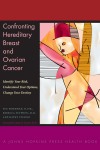Guest post by Sue Friedman
Kudos to Angelina Jolie Pitt for sharing personal information about her increased risk for breast and ovarian cancers due to an inherited BRCA gene mutation. Once again, by bravely writing about her choice to have prophylactic surgeries—a risk-reducing mastectomy two years ago, and her recent decision to remove her ovaries—she has greatly increased awareness of hereditary cancer, making words like “mutation” and “mastectomy” more familiar.
Some reports suggest that Jolie Pitt’s wealth and celebrity status provide access to information and resources that are unavailable to most other people. But her struggle to sort through the confusion of inherited cancer risk and make difficult health decisions is shared by thousands of other men and women who are also at high risk for hereditary breast and ovarian cancer because of a BRCA mutation. Fortunately, Johns Hopkins University Press offers a clear, powerful, and comforting resource for anyone who faces these confusing issues and choices. Confronting Hereditary Breast and Ovarian Cancer explains the challenges of living with BRCA-related risks and outlines the implications of available options. It helps readers understand the choices involved with identifying and reducing their risk and allows them to make informed medical decisions about their options, including many that concerned Jolie Pitt. The book covers the following issues, among others:
- Genetic testing for BRCA and other cancer-causing genes: Genetic testing isn’t appropriate for everyone, and test results can have different implications for family members.
- Mastectomy with or without breast reconstruction: Prophylactic mastectomy reduces the risk of breast cancer. Many women who choose this surgery also opt to have their breasts surgically recreated. Another Johns Hopkins publication, The Breast Reconstruction Guidebook, helps readers understand what to expect from different types of mastectomy and options for breast reconstruction.
- Risk-reducing oophorectomy and hysterectomy: Risk-reducing salpingo-oophorectomy (removal of the ovaries) has been shown to extend the lives of women who have a BRCA mutation. Confronting Hereditary Breast and Ovarian Cancer describes the pros and cons of this procedure and the implications of combining it with hysterectomy.
- Hormone replacement: Preventive hysterectomy in premenopausal women causes the onset of menopause. Should women in this position take hormones? If so, what type and for how long? Are they safe? Confronting Hereditary Breast and Ovarian Cancer tackles these questions and more.
- Fertility: Removing the ovaries reduces risk but also ends fertility, creating a very difficult situation for many women who learn that they have a mutation while still in their childbearing years.
You don’t have to be a celebrity to have access to credible information about hereditary cancer, genetic testing, and risk-management options.
Confronting Hereditary Breast and Ovarian Cancer is the official guidebook of Facing Our Risk of Cancer Empowered (FORCE), the only nonprofit organization dedicated to improving the lives of those who have inherited cancer risk. All three of the book’s coauthors will speak at FORCE’s 9th annual conference on June 18–20, 2015 in Philadelphia, PA.
 Sue Friedman, DVM, is the founder and executive director of Facing Our Risk of Cancer Empowered. Her numerous articles on hereditary cancer have appeared in Oncology Times, CURE, Gene Watch, the Boston Globe, and elsewhere. Rebecca Sutphen, MD, is a nationally recognized clinical and research expert in hereditary cancer, a professor of genetics at the University of South Florida, and the chief medical officer of Informed Medical Decisions. Kathy Steligo is a freelance writer specializing in business and health topics and the author of The Breast Reconstruction Guidebook.
Sue Friedman, DVM, is the founder and executive director of Facing Our Risk of Cancer Empowered. Her numerous articles on hereditary cancer have appeared in Oncology Times, CURE, Gene Watch, the Boston Globe, and elsewhere. Rebecca Sutphen, MD, is a nationally recognized clinical and research expert in hereditary cancer, a professor of genetics at the University of South Florida, and the chief medical officer of Informed Medical Decisions. Kathy Steligo is a freelance writer specializing in business and health topics and the author of The Breast Reconstruction Guidebook.

